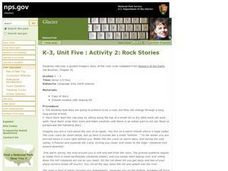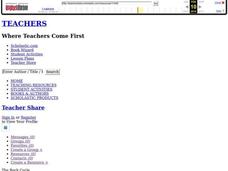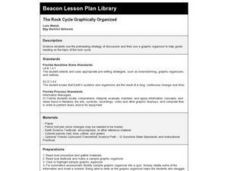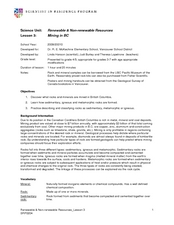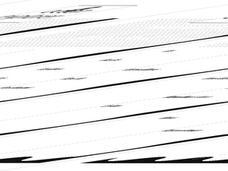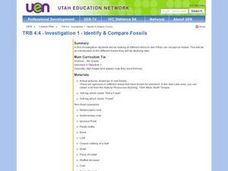Berkshire Museum
Backyard Rocks
You don't have to travel far to learn about rocks, just step outside, pick up a stone, and begin investigating. After taking a class walk around the school grounds collecting rocks, young scientists practice their skills of observation...
Curated OER
Rock Stories
Youngsters pretend they are rocks sitting on a hill. They listen to the provided guided imagery script to conceptualize the process of how rocks change over time. They draw a diagram of what happened to them as rocks during the story. An...
K5 Learning
Rocks
Five short answer questions follow an informational reading passage that details the three different types of rocks—sedimentary, igneous, metamorphic—and their rock cycle.
Curated OER
Rock Hounds
Learners receive a basis for understanding the three main classifications of rock: igneous, sedimentary and metamorphic. They engage in a hands-on activity designed to give them an appreciation for rocks and minerals.
Curated OER
It's Sedimentary, My Dear!
Pupils examine sedimentary rocks to determine how they form. In this Earth science lesson plan, students will make a rock by cementing small particles together. The pupils will then compare their observations of sedimentary rocks to the...
Curated OER
The Rock Cycle
Students explore the concept of the rock cycle. In this geology lesson, students identify, classify, and observe three different types of rocks. Students then list and char the characteristics of their rocks.
Curated OER
Rock Hounds at Heart
Second graders read "Sylvester and the Magic Pebble" by iam Steig and practice describing rocks using different physical properties. They make observations and develop and describe categories such as texture, color, density, hardness, etc.
Curated OER
The Rock Cycle Graphically Organized
Fourth graders use the prereading strategy of discussion and then use a graphic organizer to help guide reading on the topic of the rock cycle. They use a worksheet imbedded in this plan to guide thier inquiry.
Curated OER
Renewable and Non-Renewable Resources: Mining in B.C.
Students explore energy by categorizing rocks. In this British Columbia geology lesson, students define many different vocabulary terms associated with mining such as sedimentary, igneous, and metamorphic. Students utilize sample rock...
Curated OER
Rules of the Game
For this rules of the game worksheet, learners create a foldable demonstrating the laws of superposition and the principle of folding. Students will answer questions as it relates to rock layers and the principle of folding.
Curated OER
Rockin' Minerals
Third graders view a clip of the video Backyard Safari, "Rocks and Minerals," and discuss properties of rocks and minerals. They view and discuss a clip on where rocks and minerals are found.
Curated OER
Rocks Word Search Puzzle
In this literacy worksheet, students look for the words that are related to the concept that is reviewed in the sheet. They also acquire new vocabulary.
Curated OER
What is a Karst
Students investigate landforms by holding a class experiment. In this topography lesson, students define the word "karst" and discover why sinkholes are created on the surface of the Earth by completing worksheets. Students create a...
Curated OER
Jargon
Eighth graders investigate the concept of jargon and how it is used in different contexts in relation to the study of vocabulary. They practice interpreting jargon by concentrating on the comprehension strategy of using context clues.
Curated OER
Choose the Homograph
Practice homographs with this fun worksheet! Learners choose the meanings of ten homographs based on the sentence's context clues. The worksheet has a picture of bats - one flying mammal, and one used in baseball. Use this resource as a...
Curated OER
Creating Journals
Students take a virtual tour of Yosemite and selects photographs to use in their journal.
Curated OER
Investigation 1 - Identify & Compare Fossils
Fourth graders examine different items to see if they can recognize fossils. This be an introduction to the different fossils they be studying later and help them make inferences about past environments of Utah.

